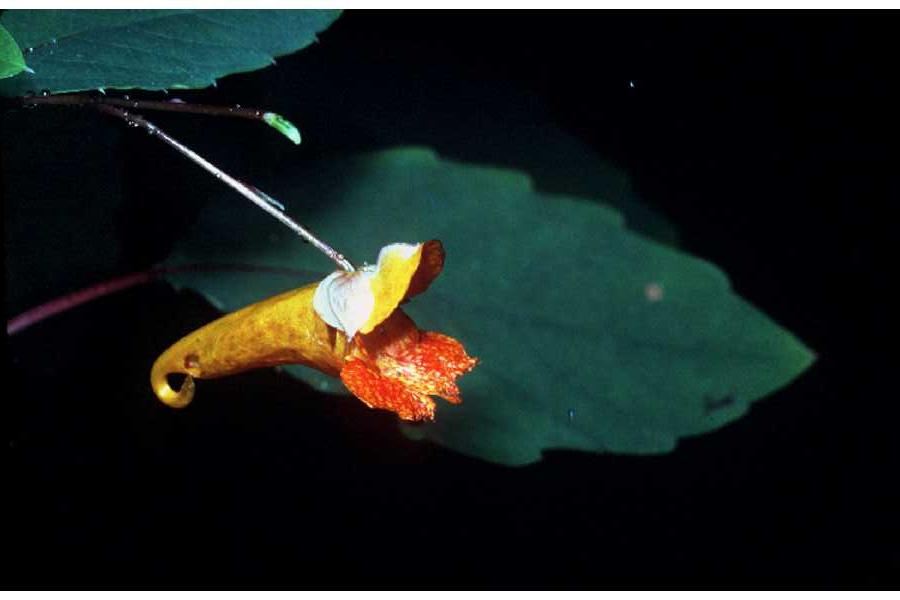- Jewelweed
image_width = 200px
image_caption = "Impatiens capensis"
regnum =Plant ae
divisio =Magnoliophyta
classis =Magnoliopsida
ordo =Ericales
familia =Balsaminaceae
genus = "Impatiens "
subdivision_ranks = Species
subdivision = See textJewelweed is a
North America n common name for a number of species offlowering plant in the genus "Impatiens ", familyBalsaminaceae , native to easternNorth America . They typically grow about 1 to 1.5 m tall, and die after one season. Like other "Impatiens", jewelweed is notable for having seed pods that burst when touched ("spring-loaded seeds"), spreading seeds over several square meters. Because of this, it also has the common name (shared with many other "Impatiens" species) of Touch-me-not. Jewelweed is often used as a home remedy to treatpoison ivy rashes, but has been shown not to have any anti-itch properties in several controlled studies.Species
Species called jewelweed include:
* "
Impatiens capensis " Meerb. — Spotted Jewelweed or Orange Jewelweed; orange flowers
* "Impatiens pallida " Nutt. — Pale Jewelweed or Yellow Jewelweed; yellow (rarely cream-colored) flowers.These species grow in moist, rich soils in valleys and stream-bottoms. Pale jewelweed tends to grow slightly taller and to tolerate somewhat shadier sites than orange jewelweed, while the latter is more common and better able to grow in disturbed areas.
An oft-repeated
folk saying , "Wherever poison ivy is found, jewelweed grows close by," is not true. Poison ivy grows in a wide variety of habitats, while jewelweed is restricted to moist bottomlands and valleys with rich soil. The reverse is often true: wherever jewelweed is found, poison ivy is usually close by. Jewelweed grows in sunny, wet areas, such as roadside ditches andfens .Jewelweed's 1 cm (½ inch) long flowers are shaped like a shoe. Some plants have orange flowers with dark spots, while others have plain yellow flowers. When held under water, the leaves appear silvery in color (most noticeably on the underside of the leaf) due to tiny air bubbles trapped across the leaf surface. Also, when water collects on the leaves of the Jewelweed, it tends to clump together because of the smooth texture of the leaves. White light can then be refracted through the prism, thus presenting the color spectrum, giving it the appearance of a jewel. These two characteristics possibly explain the plant's common name.
In the 19th and 20th centuries, humans transported the Orange Jewelweed ("Impatiens capensis") to England, France, the Netherlands, Poland, Sweden, Finland, and potentially other areas of Northern and Central Europe. These naturalized populations persist in the absence of any common cultivation by people. The orange jewelweed is quite similar to "
Impatiens noli-tangere ", an Impatiens species native to Europe and Asia. No evidence exists of natural hybrids, although the habitats occupied by the two species are very similar. There are currently no records of pale jewelweed being cultivated outside North America, nor are there documented naturalizations.Medical use
Jewelweed has been shown to be devoid of any anti-itch activity (
antipruritic effect) in several controlled studies, but is still used widely as a home remedy againstpoison ivy rashes, bee stings, andinsect bite s. [D. Long, N. H. Ballentine, J. G. Marks. "Treatment of poison ivy/oak allergic contact dermatitis with an extract of jewelweed." Am. J. Contact. Dermat. 8(3):150-3 1997 PMID 9249283] [M. R. Gibson, F. T. Maher. "Activity of jewelweed and its enzymes in the treatment of Rhus dermatitis." J. Am. Pharm. Assoc. Am. Pharm. Assoc. 39(5):294-6 1950 PMID 15421925] [J. D. Guin, R. Reynolds. "Jewelweed treatment of poison ivy dermatitis." Contact Dermatitis 6(4):287-8 1980 PMID 6447037, doi|10.1111/j.1600-0536.1980.tb04935.x] [B. J. Zink, E. J. Otten, M. Rosenthal, B. Singal. "The effect of jewel weed in preventing poison ivy dermatitis." Journal of Wilderness Medicine 2(3):178–182 1991, [http://www.wemjournal.org/wmsonline/?request=get-abstract&issn=0953-9859&volume=002&issue=03&page=0178 abstract] ] Jewelweed contains thenaphthoquinone lawsone , adye that is also found inHenna and that is responsible for the permanenthair coloring and skin coloring inmehndi .See also
*
Antipruritic External links
* [http://www.usi.edu/science/biology/TwinSwamps/jpeg%20pix/jewelweed%20cu%20copy.jpgJewelweed image]
* [http://www.econetwork.net/~wildmansteve/Plants.Folder/Jewelweed.html "Identifying and harvesting edible and medicinal plants in wild (and not-so-wild) places"]References
Wikimedia Foundation. 2010.

